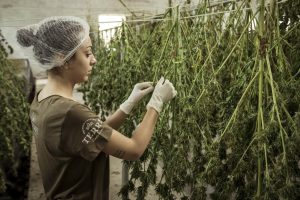7.1 Chapter Overview and Learning Objectives
7.1.1 Learning Objectives
After reading this chapter, you will be able to do the following:
- Explain how deviance is socially constructed and how social control is enforced.
- Discuss historical and contemporary theories of deviance and crime.
- Identify and explain key elements of the U.S. criminal justice system.
- Examine the relationship between race, identity, and the U.S. criminal justice system
- Describe challenges to the contemporary U.S. criminal justice system.
- Compare and contrast cross-cultural examples of justice systems.

Marijuana first began being made illegal in the early 1900s. The federal government passed the 1937 Marihuana Tax Act, which effectively banned the plant, in response to political pressure from those who had racially biased fears of its use by Mexicans (Musto 1972). Marijuana’s later association with hippies helped justify crackdowns on anti-war protestors and other leftist movements by the Nixon administration (Baum 2016). In the decades that followed, police and judges disproportionately arrested and imprisoned blacks and Latinos for the use and sale of marijuana (Golub, Johnson, and Dunlap 2007; American Civil Liberties Union [ACLU] 2020). Even today, marijuana continues to be illegal in many states in the United States – with penalties ranging from jail time to fines to probation.
Within the past decade, though, marijuana laws have slowly shifted. As of 2022, 19 states have legalized marijuana for recreational use, and 39 states have legalized marijuana for medical use (National Conference of State Legislators [NCSL] 2022). Since there are so many different policies, how should we view marijuana? Should marijuana still be considered a dangerous, illegal drug because it is still federally illegal? Should marijuana be regarded as a healing plant that can play a role in addressing medical issues? Should marijuana be considered taboo but not be subject to legal penalties for its use or possession? Or should marijuana be considered a legal, acceptable substance to use recreationally? There are no correct answers to these questions, but they demonstrate how the status of marijuana continues to be redefined by society.
Equity issues have become apparent as marijuana has become legalized in many states. Black and Latino communities have been disproportionately arrested and imprisoned for marijuana offenses. As marijuana has become legalized, these groups have not had the same ability to participate in the legal market. Licenses to open medical or recreational dispensaries often cost hundreds of thousands of dollars. Consequently, white men dominate the legal marijuana market because they can afford the exorbitant start-up costs. All the while, blacks and Latinos (in both legal and non-legal states) serve prison sentences for engaging in the same activity. How do we ensure equity in this emerging legal market and new legal context?
How can we use our sociological imagination to understand the role of marijuana in our society? As marijuana has become legalized, how do we ensure that those most impacted by the war on drugs have the opportunity to participate in the legal market? In what follows, we will provide you with tools to understand how and why our definitions of what is legal or illegal and acceptable or unacceptable change over time. At the same time, we’ll dig deeper into debates around equity. By looking at how groups have been treated differently by the criminal justice system, we’ll think critically about the impacts of marijuana legalization.
7.1.2 Licenses and Attributions for Overview
“Overview” by Alexandra Olsen is licensed under CC BY 4.0.
Figure 7.1. Chapter opening image of woman separating drying cannabis. Photo by Andrea Porziella – Terre di Cannabis. Cannabis drying. License: Unsplash
